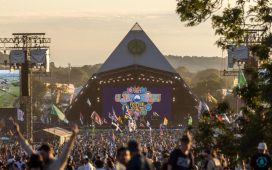A few weeks ago, in the vast, empty expanse of the West Hall in London’s Alexandra Palace, Nick Cave sat alone at a piano and sang 21 songs from across his extensive back catalogue. Live-streamed globally last Thursday, Idiot Prayer: Nick Cave Alone at Alexandra Palace, a film of that performance, is the most elaborately creative response yet to the constrictions of the lockdown.
In April, the onset of the pandemic cost Cave and the Bad Seeds the European and American legs of their world tour, which was rumoured to have been a spectacular production that would include a full gospel choir. Compared to, say, Laura Marling’s recent show on the stage of an empty Union Chapel in London, Cave’s solo performance was an extravagantly grand event that called on the services of the renowned Irish cinematographer Robbie Ryan (The Favourite, Marriage Story, American Honey), a full film crew and an extensive production team. His wife, Susie, was creative director.
The film begins with a self-consciously theatrical flourish: a shot of the singer sitting in a chair writing in a notebook, looking immaculately stylish as always in, as the end credits reveal, a tailormade Gucci suit. The camera then trails Cave as, silhouetted in half-light, he makes his way down a wide staircase and through several other ornately decorated rooms towards the performance space. On the accompanying soundtrack he recites an amended version of Spinning Song, a quasi-allegorical track from his most recent album, Ghosteen.
After that, for the next hour and 30 minutes, it’s all about the songs and Cave’s commanding presence, by turns dramatic and quietly transfixing. The setlist leans heavily on The Boatman’s Call, his most contemplative album, but there are also several surprises. A haunting Sad Waters from 1986’s Your Funeral, My Trial, sounded almost elegiac in this starker setting. Then, a quietly reverent Brompton Oratory gives way to the extravagant lyricism of Grinderman’s Palaces of Montezuma, one of several dramatic juxtapositions that highlight the range of Cave’s extensive back catalogue.
As we know from past outings, Cave’s ballads, whether a lovelorn cri de coeur such as Far From Me or a feverish death song such as The Mercy Seat, tend to work equally well in a solo piano setting. Both songs feature here, the former even more regretful than the original, the latter restrained and haunting until it builds slowly into something more chilling.
More intriguing, though, are his deft readings of more recent songs from the album trilogy of Push the Sky Away, Skeleton Tree and Ghosteen, many of which forgo the traditional narrative form for an almost stream-of-consciousness lyricism tied to often dissonant sonic settings. Girl in Amber, stripped of the electronically treated voices, becomes a very different song, Cave’s emphatic delivery imbuing it with an even more visceral sense of grief and isolation. Euthanasia, a track that did not make it on to Skeleton Tree, debuted here, summons up the spirit of the young Van Morrison in its incantatory vocal repetitions.
As the performance unfolds, you sense Cave settling into the songs, inhabiting them entirely as if immersed in his own private space. Jubilee Street, while not possessing the spiralling momentum of the band version, is nevertheless dramatic, Cave pounding on the keys as if willing it towards its dizzying conclusion. Likewise, a pared-to-the-bone Higgs Boson Blues retains its surreal, disorienting momentum against all the odds.
Things shift gear towards the end, first with a dramatic Papa Won’t Leave You, Henry, a slice of southern gothic that will please those longtime fans who – to paraphrase Cave’s friend Shane MacGowan – wish he would head back into the swamp more often. The performance ends quietly with a tenderly stoical Black Hair and a sparse, elegiac Galleon Ship, which, without the otherworldly electronic atmospherics of the Ghosteen version, sound even more affecting.
Throughout, Nick Cave speaks not a word, which only adds to the sombre, slightly unreal atmosphere. Only a wry smile and a quick laugh at the end of (Are You) the One That I’ve Been Waiting For? fractures the prevailing mood of quiet intensity. Though deftly edited, the film is a record of a single, uninterrupted performance. “You will not be able to pause, rewind or fast-forward the stream,” the website warns, as if acknowledging the strange hinterland this kind of meticulously staged digital event occupies.

The illusion of total intimacy is broken only once when, during Higgs Boson Blues, an aerial shot reveals the presence of the camera crew quietly at work in the foreground. It’s a neat acknowledgment of the many ironies that attend this kind of event, not least the fact that the presence of the film crew affords us the kind of intimacy that a live gig, however small, could never convey. Conversely, those between-song silences are a reminder that, without an audience, something crucial is lost: that sense of being there in a room with the performer; those taut moments of rapt stillness that give way to noisy appreciation.
Ultimately, for all the elaborate staging and the high-end production, it is Cave’s commanding presence as a performer that compels. Throughout, his extraordinarily expressive face is a measure of his immersion in these old and new songs. At the end, he stands up and walks off into the light. One hopes that the crew burst into spontaneous applause.














